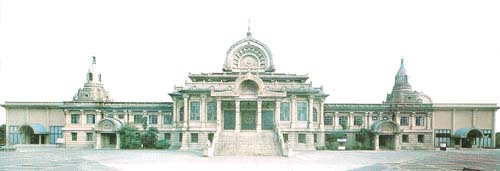
Tsukiji Hongwanji
A Jodo Shinshu Buddhist temple
(Shin Buddhism)
Located only minutes away from the Ginza
in central
Tokyo,
the Tsukiji Hongwanji has served as an oasis for centuries.
HOME NEXT
MENU TOP BOTTOM
UPDATED: April 2012.
The Tsukiji Hongwanji Betsuin was re-classified within the
Hongwanji Temple System.
The temple is no longer a Betsuin, or Branch Temple, of the Mother Temple, but now a direct temple in Tokyo of the Hongwanji.
This became effective, 1 April 2012. |
 To explore these pages, you
can use the MENU or NEXT buttons. MENU will
send you to the list of available
pages. NEXT will take you page by page through
all the information here.
To explore these pages, you
can use the MENU or NEXT buttons. MENU will
send you to the list of available
pages. NEXT will take you page by page through
all the information here.
- Welcome to Tsukiji Hongwanji.
- About this home page
- A very brief outline of Jodo Shinshu.
- Guest Book [DEACTIVATED] Please Email your
comments Email
Welcome to Tsukiji Hongwanji Buddhist Temple
 The Tsukiji Hongwanji Temple is the Tokyo temple of the Jodo Shinshu (sect)
[Shin Buddhism] Hongwanji-ha (sub-sect), which is one of the largest Japanese
Buddhist denominations. The Mother Temple or Honzan is located in Kyoto. Due to the Mother Temple's geographic location within
Kyoto, the denomination is commonly known as Nishi (West) Hongwanji.
The Tsukiji Hongwanji Temple is the Tokyo temple of the Jodo Shinshu (sect)
[Shin Buddhism] Hongwanji-ha (sub-sect), which is one of the largest Japanese
Buddhist denominations. The Mother Temple or Honzan is located in Kyoto. Due to the Mother Temple's geographic location within
Kyoto, the denomination is commonly known as Nishi (West) Hongwanji.
 Hongwanji is one of the earliest Japanese Buddhist Denominations to begin
propagating abroad, with officially over a century and a half history overseas.
Hongwanji is one of the earliest Japanese Buddhist Denominations to begin
propagating abroad, with officially over a century and a half history overseas.
An outline of Jodo Shinshu:
 Jodo Shinshu is a Buddhist Denomination. It is in the lineage of Jodo (Pure
Land) Buddhism. From the vast amount of teachings by the historical
Shakamuni Buddha roughly 2500 years ago, succeeding Masters have propagated
the teaching of NEMBUTSU or the recitation of the Buddha name, NAMO AMIDA
BUTSU, through the centuries.
Jodo Shinshu is a Buddhist Denomination. It is in the lineage of Jodo (Pure
Land) Buddhism. From the vast amount of teachings by the historical
Shakamuni Buddha roughly 2500 years ago, succeeding Masters have propagated
the teaching of NEMBUTSU or the recitation of the Buddha name, NAMO AMIDA
BUTSU, through the centuries.
 Shin Buddhism can be said to have been founded by Shinran Shonin (1173-1263) in Japan [Shonin is a title of respect meaning "sacred person"]. As a successor to Master Honen (1133-1212), the Founder of Jodo-shu (Pure Land School), the Shonin's teaching was based on the Pure Land tradition. His teaching maintained that SHINJIN, endowed by Amida Buddha, assured unconditional attainment of Buddhahood (or Enlightenment), once a person single-heartedly received Amida Buddha's HONGWAN (Original Intent). Shinran Shonin has stressed that Nembutsu is an expression of gratitude.
Shin Buddhism can be said to have been founded by Shinran Shonin (1173-1263) in Japan [Shonin is a title of respect meaning "sacred person"]. As a successor to Master Honen (1133-1212), the Founder of Jodo-shu (Pure Land School), the Shonin's teaching was based on the Pure Land tradition. His teaching maintained that SHINJIN, endowed by Amida Buddha, assured unconditional attainment of Buddhahood (or Enlightenment), once a person single-heartedly received Amida Buddha's HONGWAN (Original Intent). Shinran Shonin has stressed that Nembutsu is an expression of gratitude.
It should be noted that Pure Land traditions existed in China,
prior to being propagated to Japan.
 The term Jodo Shinshu was used by Shinran Shonin, to mean "the true
essence of the Pure Land Teachings" of Master Honen. Although the
Shonin never deviated from the his stance that he was a disciple of Master
Honen, this difference led to an independent sect from that of Jodo-shu
through the generations. The sect eventually came to be called Jodo Shinshu
(Shin Buddhism).
The term Jodo Shinshu was used by Shinran Shonin, to mean "the true
essence of the Pure Land Teachings" of Master Honen. Although the
Shonin never deviated from the his stance that he was a disciple of Master
Honen, this difference led to an independent sect from that of Jodo-shu
through the generations. The sect eventually came to be called Jodo Shinshu
(Shin Buddhism).
 Currently, The Hongwanji-ha Hongwanji (HOMPA) and the Otani-ha Honganji
(DAIHA) are the two largest sub-sects in this tradition.
Currently, The Hongwanji-ha Hongwanji (HOMPA) and the Otani-ha Honganji
(DAIHA) are the two largest sub-sects in this tradition.
HOME BACK
NEXT TOP BOTTOM
History:
 The history of this temple
dates back to the year 1617 when Junnyo Shonin,
the 12th hierarchial leader
or Monshu of the Hongwanji, established a
temple at Yokoyama-cho near Asakusa
in Edo(olden-day Tokyo). Called in those days as
the Edo-Asakusa
Gobo, the temple was lost to flames in the Great
Fire of 1657.
Unfortunately, permission for rebuilding
at its original site was denied
by the Tokugawa Bakufu (the feudal government)
due to it not being in accord with its reconstruction
plans for the area.
Land allocated in exchange was a parcel of
land off the shoreline of Hatchobori
which had to be reclaimed from the sea. This
land reclamation and reconstruction
project was undertaken by countless devout
followers centered around those
living on nearby Tsukudajima. The word Tsukiji literally means "built-up
land", pointing to the fact that this
district was obviously reclaimed
land. The district around the temple is called
Tsukiji due to such historical
background. When the Main Worhip Hall or
Hondo was built
on this land, the temple came to be called
Tsukiji Gobo.
The history of this temple
dates back to the year 1617 when Junnyo Shonin,
the 12th hierarchial leader
or Monshu of the Hongwanji, established a
temple at Yokoyama-cho near Asakusa
in Edo(olden-day Tokyo). Called in those days as
the Edo-Asakusa
Gobo, the temple was lost to flames in the Great
Fire of 1657.
Unfortunately, permission for rebuilding
at its original site was denied
by the Tokugawa Bakufu (the feudal government)
due to it not being in accord with its reconstruction
plans for the area.
Land allocated in exchange was a parcel of
land off the shoreline of Hatchobori
which had to be reclaimed from the sea. This
land reclamation and reconstruction
project was undertaken by countless devout
followers centered around those
living on nearby Tsukudajima. The word Tsukiji literally means "built-up
land", pointing to the fact that this
district was obviously reclaimed
land. The district around the temple is called
Tsukiji due to such historical
background. When the Main Worhip Hall or
Hondo was built
on this land, the temple came to be called
Tsukiji Gobo.
Current Structure:

 As with most other buildings
in Tokyo, the previous grand wooden temple
building was lost in the 1923
Great Kanto Earthquake. Under the direction
of Monshu Kozui Ohtani (Myonyo
Shonin), the 22rd Monshu, the present ferro-concrete
temple building with its Indian architectural
motif was designed by Chuta Ito, Professor
of the Faculty of Architecture
at Tokyo University. The reconstruction began
in the year 1931 and was
completed in 1934, displaying the fervent
devotion of the Shinshu followers.
As with most other buildings
in Tokyo, the previous grand wooden temple
building was lost in the 1923
Great Kanto Earthquake. Under the direction
of Monshu Kozui Ohtani (Myonyo
Shonin), the 22rd Monshu, the present ferro-concrete
temple building with its Indian architectural
motif was designed by Chuta Ito, Professor
of the Faculty of Architecture
at Tokyo University. The reconstruction began
in the year 1931 and was
completed in 1934, displaying the fervent
devotion of the Shinshu followers.
HOME BACK
NEXT MENU TOP
BOTTOM
The Temple Complex

^ The
Dai-ichi Dendo Kaikan The
Dai-ni Dendo Kaikan ^
The
Dai-ni Dendo Kaikan ^
 Tsukiji Hongwanji is located at 3-15-1 Tsukiji, Chuo Ward, Tokyo. It is a brisk fifteen minute walk towards the Harumi Pier from the Ginza, or about seven minutes from the KABUKI Theater. Access is also possible using the Hibiya Line Subway "TSUKIJI Station", the O-Edo Subway Line "TSUKIJI-SHIJOH Station", or by Metropolitan bus. Nearby are the National Cancer Center and the Tokyo Metropolitan Central Fish Market.
Tsukiji Hongwanji is located at 3-15-1 Tsukiji, Chuo Ward, Tokyo. It is a brisk fifteen minute walk towards the Harumi Pier from the Ginza, or about seven minutes from the KABUKI Theater. Access is also possible using the Hibiya Line Subway "TSUKIJI Station", the O-Edo Subway Line "TSUKIJI-SHIJOH Station", or by Metropolitan bus. Nearby are the National Cancer Center and the Tokyo Metropolitan Central Fish Market.
The Hondo (Main Worship Hall)
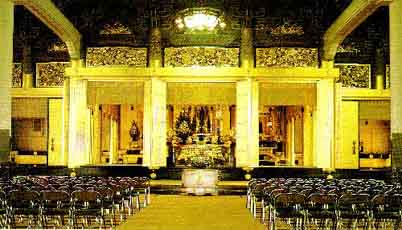
Inside the Hondo
The Main Altar (Inner Adytum)
(left auxiliary altar) (right auxiliary
altar)
The Buddha of Worship: Amida Buddha
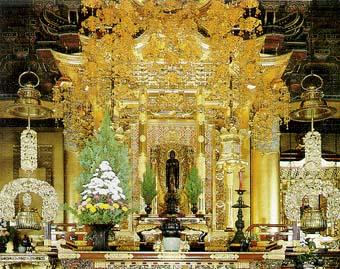
The Central Buddha of Worship:
Amida Buddha (Buddha Amitabha, Amitayus)
 Enshrined within the central altar in the Main Worhip Hall is the personified
image of the Amida Buddha (Buddha Amitabha, Amitayus). Out of pure infinite
wisdom and limitless compassion, the Amida Buddha vowed to give unconditional
Enlightenment to all sentient beings, whose very nature could only look
lightly upon the Buddha Dharma and/or have no other means of being saved.
To express the Buddha's boundless wisdom and compassion, the Buddha image
is shown to be emitting an unobstructable ray of compassion in all directions
(the ten quarters), enveloping all beings. The standing image signifies
the Buddha is dynamically pursuing to reach and save all beings by calling
"Namo Amida Butsu" upon them to rely upon the Amida Buddha.
Enshrined within the central altar in the Main Worhip Hall is the personified
image of the Amida Buddha (Buddha Amitabha, Amitayus). Out of pure infinite
wisdom and limitless compassion, the Amida Buddha vowed to give unconditional
Enlightenment to all sentient beings, whose very nature could only look
lightly upon the Buddha Dharma and/or have no other means of being saved.
To express the Buddha's boundless wisdom and compassion, the Buddha image
is shown to be emitting an unobstructable ray of compassion in all directions
(the ten quarters), enveloping all beings. The standing image signifies
the Buddha is dynamically pursuing to reach and save all beings by calling
"Namo Amida Butsu" upon them to rely upon the Amida Buddha.
 According to the sutras,
while the Buddha was still the Bodhisattva
Dharamakara (a practicing Bodhisattva;
a Buddha aspirant), Vows were made to strive
to attain a means of saving
all beings without fail. The sutras further
state that Bodhisattva Dharamakara
fulfilled all and attained Enlightenment
(Buddhahood) and came to be called
the Amida Buddha. Through these Vows (Hongwan),
those who attain birth
in the Pure Land of Amida immediately receives
the same amount of merits
accumulated by the Bodhisattva Dharmakara
in the process of becoming the
Amida Buddha and therefore is able to attain
Buddhahood, whereafter they
will also be taking an active role in helping
other sentient beings attain
Enlightenment.
According to the sutras,
while the Buddha was still the Bodhisattva
Dharamakara (a practicing Bodhisattva;
a Buddha aspirant), Vows were made to strive
to attain a means of saving
all beings without fail. The sutras further
state that Bodhisattva Dharamakara
fulfilled all and attained Enlightenment
(Buddhahood) and came to be called
the Amida Buddha. Through these Vows (Hongwan),
those who attain birth
in the Pure Land of Amida immediately receives
the same amount of merits
accumulated by the Bodhisattva Dharmakara
in the process of becoming the
Amida Buddha and therefore is able to attain
Buddhahood, whereafter they
will also be taking an active role in helping
other sentient beings attain
Enlightenment.
HOME BACK
NEXT MENU TOP
BOTTOM
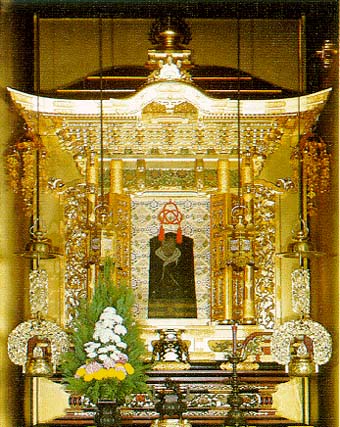
The Founder: Shinran Shonin (1173-1262)
Shinran Shonin (1173-1262) (right auxiliary
altar)
 An image of the founder
of Jodo Shinshu Sect, Shinran Shonin, is
enshrined within the right auxiliary
altar.
An image of the founder
of Jodo Shinshu Sect, Shinran Shonin, is
enshrined within the right auxiliary
altar.
 Shinran Shonin never intended to establish
a new sect, but was only a follower of
Master
Honen. Although this is true, the deviation
from Master Honen's Jodo-shu was inherent,
as Shinran Shonin's teachings placed complete
reliance upon Amida Buddha's HONGWAN TARIKI
(The Amida Buddha's Very Intent). Master
Honen's Jodo-shu did not. This critical
difference
eventually led to the establishment of
a
new sect by the succeeding Shinran followers.
Shinran Shonin never intended to establish
a new sect, but was only a follower of
Master
Honen. Although this is true, the deviation
from Master Honen's Jodo-shu was inherent,
as Shinran Shonin's teachings placed complete
reliance upon Amida Buddha's HONGWAN TARIKI
(The Amida Buddha's Very Intent). Master
Honen's Jodo-shu did not. This critical
difference
eventually led to the establishment of
a
new sect by the succeeding Shinran followers.
 Lost in a labyrinth of
personal desires, it is impossible for us
sentient beings living in the
present time known as "Period of Decedant
Dharma" to free oneself
of suffering and ignorance by relying upon
one's own power. Shinran Shonin
spent his life of 90 years in the propagation
of the Nembutsu, or Amida
Buddha's call from the Pure Land which can
be heard as saying, "I
will protect all of you." This calling
is aimed at all those living
a life similar to one struggling in quicksand,
with no other way of being
saved except for meeting with this Amida's
calling.
Lost in a labyrinth of
personal desires, it is impossible for us
sentient beings living in the
present time known as "Period of Decedant
Dharma" to free oneself
of suffering and ignorance by relying upon
one's own power. Shinran Shonin
spent his life of 90 years in the propagation
of the Nembutsu, or Amida
Buddha's call from the Pure Land which can
be heard as saying, "I
will protect all of you." This calling
is aimed at all those living
a life similar to one struggling in quicksand,
with no other way of being
saved except for meeting with this Amida's
calling.
 Only by relying upon Amida's
Vow (Tariki: Action on part of the Amida Buddha) and
living accordingly with Shinjin (absolute
assurance endowed by Amida Buddha) can
one
endure the sufferings and hardships of
our
lifetime, transforming each of them into
meaningful "once-in-a-lifetime"
occurences. The transmission from India,
to China and Japan of this ever-powerful,
all-encompassing Vow of Amida Buddha can
be seen in Shinran Shonin's main writing,
KYO-GYO-SHIN-SHO.
Only by relying upon Amida's
Vow (Tariki: Action on part of the Amida Buddha) and
living accordingly with Shinjin (absolute
assurance endowed by Amida Buddha) can
one
endure the sufferings and hardships of
our
lifetime, transforming each of them into
meaningful "once-in-a-lifetime"
occurences. The transmission from India,
to China and Japan of this ever-powerful,
all-encompassing Vow of Amida Buddha can
be seen in Shinran Shonin's main writing,
KYO-GYO-SHIN-SHO.
 The Nembutsu has since been
propagated worldwide.
The Nembutsu has since been
propagated worldwide.
- HOME BACK
NEXT MENU TOP
BOTTOM
-
Shonyo Shonin (The 23rd Monshu)
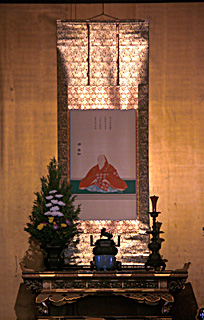
Shonyo Shonin (left auxiliary altar)
- Shonyo Shonin (1911-2002) was the 23rd MONSHU of the Nishi Hongwanji in
Kyoto, which is the Mother Temple of the Tsukiji Hongwanji.
- The MONSHU is the Spiritual Leader and Head of the Hongwanji, and is a
direct descendant of Shinran Shonin.
- Shonyo Shonin dynamically traveled to spread the Nembutsu Teachings both
domestically and abroad, so that both priests and lay will not be followers
"in name only".
He was the previous Resident Minister of the Tsukiji Hongwanji.
HOME BACK
MENU TOP BOTTOM
COMMENT Return
to TOP INDEX
E-Mail: K. Yamamoto
URL: www.myouenji.ws
Text - Copyright 1995 - 2012, KYamamoto.
Photographs courtesy of Tsukiji Hongwanji
Betsuin, copyright 1995.
Web Layout - Copyright; 1995 through 2012. K. Yamamoto / Myouenji
About the author:
Koshin Yamamoto is the head resident priest
at Myouenji Buddhist Temple
in Kawasaki. He is also one of the English
speaking ministers affiliated
with Tsukiji Hongwanji.


![]() To explore these pages, you
can use the MENU or NEXT buttons. MENU will
send you to the list of available
pages. NEXT will take you page by page through
all the information here.
To explore these pages, you
can use the MENU or NEXT buttons. MENU will
send you to the list of available
pages. NEXT will take you page by page through
all the information here.![]() Jodo Shinshu is a Buddhist Denomination. It is in the lineage of Jodo (Pure
Land) Buddhism. From the vast amount of teachings by the historical
Shakamuni Buddha roughly 2500 years ago, succeeding Masters have propagated
the teaching of NEMBUTSU or the recitation of the Buddha name, NAMO AMIDA
BUTSU, through the centuries.
Jodo Shinshu is a Buddhist Denomination. It is in the lineage of Jodo (Pure
Land) Buddhism. From the vast amount of teachings by the historical
Shakamuni Buddha roughly 2500 years ago, succeeding Masters have propagated
the teaching of NEMBUTSU or the recitation of the Buddha name, NAMO AMIDA
BUTSU, through the centuries.![]() Shin Buddhism can be said to have been founded by Shinran Shonin (1173-1263) in Japan [Shonin is a title of respect meaning "sacred person"]. As a successor to Master Honen (1133-1212), the Founder of Jodo-shu (Pure Land School), the Shonin's teaching was based on the Pure Land tradition. His teaching maintained that SHINJIN, endowed by Amida Buddha, assured unconditional attainment of Buddhahood (or Enlightenment), once a person single-heartedly received Amida Buddha's HONGWAN (Original Intent). Shinran Shonin has stressed that Nembutsu is an expression of gratitude.
Shin Buddhism can be said to have been founded by Shinran Shonin (1173-1263) in Japan [Shonin is a title of respect meaning "sacred person"]. As a successor to Master Honen (1133-1212), the Founder of Jodo-shu (Pure Land School), the Shonin's teaching was based on the Pure Land tradition. His teaching maintained that SHINJIN, endowed by Amida Buddha, assured unconditional attainment of Buddhahood (or Enlightenment), once a person single-heartedly received Amida Buddha's HONGWAN (Original Intent). Shinran Shonin has stressed that Nembutsu is an expression of gratitude.![]() The term Jodo Shinshu was used by Shinran Shonin, to mean "the true
essence of the Pure Land Teachings" of Master Honen. Although the
Shonin never deviated from the his stance that he was a disciple of Master
Honen, this difference led to an independent sect from that of Jodo-shu
through the generations. The sect eventually came to be called Jodo Shinshu
(Shin Buddhism).
The term Jodo Shinshu was used by Shinran Shonin, to mean "the true
essence of the Pure Land Teachings" of Master Honen. Although the
Shonin never deviated from the his stance that he was a disciple of Master
Honen, this difference led to an independent sect from that of Jodo-shu
through the generations. The sect eventually came to be called Jodo Shinshu
(Shin Buddhism).![]() Currently, The Hongwanji-ha Hongwanji (HOMPA) and the Otani-ha Honganji
(DAIHA) are the two largest sub-sects in this tradition.
Currently, The Hongwanji-ha Hongwanji (HOMPA) and the Otani-ha Honganji
(DAIHA) are the two largest sub-sects in this tradition.![]() The history of this temple
dates back to the year 1617 when Junnyo Shonin,
the 12th hierarchial leader
or Monshu of the Hongwanji, established a
temple at Yokoyama-cho near Asakusa
in Edo(olden-day Tokyo). Called in those days as
the Edo-Asakusa
Gobo, the temple was lost to flames in the Great
Fire of 1657.
Unfortunately, permission for rebuilding
at its original site was denied
by the Tokugawa Bakufu (the feudal government)
due to it not being in accord with its reconstruction
plans for the area.
Land allocated in exchange was a parcel of
land off the shoreline of Hatchobori
which had to be reclaimed from the sea. This
land reclamation and reconstruction
project was undertaken by countless devout
followers centered around those
living on nearby Tsukudajima. The word Tsukiji literally means "built-up
land", pointing to the fact that this
district was obviously reclaimed
land. The district around the temple is called
Tsukiji due to such historical
background. When the Main Worhip Hall or
Hondo was built
on this land, the temple came to be called
Tsukiji Gobo.
The history of this temple
dates back to the year 1617 when Junnyo Shonin,
the 12th hierarchial leader
or Monshu of the Hongwanji, established a
temple at Yokoyama-cho near Asakusa
in Edo(olden-day Tokyo). Called in those days as
the Edo-Asakusa
Gobo, the temple was lost to flames in the Great
Fire of 1657.
Unfortunately, permission for rebuilding
at its original site was denied
by the Tokugawa Bakufu (the feudal government)
due to it not being in accord with its reconstruction
plans for the area.
Land allocated in exchange was a parcel of
land off the shoreline of Hatchobori
which had to be reclaimed from the sea. This
land reclamation and reconstruction
project was undertaken by countless devout
followers centered around those
living on nearby Tsukudajima. The word Tsukiji literally means "built-up
land", pointing to the fact that this
district was obviously reclaimed
land. The district around the temple is called
Tsukiji due to such historical
background. When the Main Worhip Hall or
Hondo was built
on this land, the temple came to be called
Tsukiji Gobo.![]() As with most other buildings
in Tokyo, the previous grand wooden temple
building was lost in the 1923
Great Kanto Earthquake. Under the direction
of Monshu Kozui Ohtani (Myonyo
Shonin), the 22rd Monshu, the present ferro-concrete
temple building with its Indian architectural
motif was designed by Chuta Ito, Professor
of the Faculty of Architecture
at Tokyo University. The reconstruction began
in the year 1931 and was
completed in 1934, displaying the fervent
devotion of the Shinshu followers.
As with most other buildings
in Tokyo, the previous grand wooden temple
building was lost in the 1923
Great Kanto Earthquake. Under the direction
of Monshu Kozui Ohtani (Myonyo
Shonin), the 22rd Monshu, the present ferro-concrete
temple building with its Indian architectural
motif was designed by Chuta Ito, Professor
of the Faculty of Architecture
at Tokyo University. The reconstruction began
in the year 1931 and was
completed in 1934, displaying the fervent
devotion of the Shinshu followers.
![]() Tsukiji Hongwanji is located at 3-15-1 Tsukiji, Chuo Ward, Tokyo. It is a brisk fifteen minute walk towards the Harumi Pier from the Ginza, or about seven minutes from the KABUKI Theater. Access is also possible using the Hibiya Line Subway "TSUKIJI Station", the O-Edo Subway Line "TSUKIJI-SHIJOH Station", or by Metropolitan bus. Nearby are the National Cancer Center and the Tokyo Metropolitan Central Fish Market.
Tsukiji Hongwanji is located at 3-15-1 Tsukiji, Chuo Ward, Tokyo. It is a brisk fifteen minute walk towards the Harumi Pier from the Ginza, or about seven minutes from the KABUKI Theater. Access is also possible using the Hibiya Line Subway "TSUKIJI Station", the O-Edo Subway Line "TSUKIJI-SHIJOH Station", or by Metropolitan bus. Nearby are the National Cancer Center and the Tokyo Metropolitan Central Fish Market.

